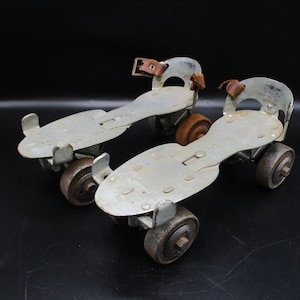








American Rusty Gold
Eagle Mfg. Co Pre-1970 Teapot Oil Can-USA
$20.00
-
DetailsThis can has been altered for someone's alternative use. As far as I can tell , the "LUB OIL ONLY" copper
metal tag was added and tip of spout sheared for a wider and faster pour. It has a worn, rustic patina and lid removes and fastens easily. Chain is missing and has some dents....see photos.
Weighs 1 lb empty
Measures 10" Wide 6.5" Tall Base Circumference 5.5" X 5.5"
The Eagle Glass and Manufacturing Company was established on January 1, 1894, in Wellsburg, West Virginia, by three brothers. James Paull, Harry W. Paull, and Samuel O. Paull started the company when they purchased a small glass factory in Wellsburg from the Wheeling Lamp and Stamping Company.
The Company was incorporated in 1897, and the original certificate of incorporation was for the stated purpose of manufacturing, buying, and selling a variety of glassware. Some of the first products manufactured by Eagle were opal disks used to line the insides of Mason fruit jar caps.
In the early 1900's, Eagle added a metal manufacturing department to its operations. Initially, the metal department manufactured lids for the glass jars that were the central element of Eagle’s productions in the early years. In 1907 the company began to produce welded steel cans for railroad, quarry, and factory use. These cans were initially produced in six sizes ranging from one-half to 5-gallons.
By 1921, Eagle’s metal department was larger than its glass department. The metal plant would go on to become the largest manufacturer of metal oil cans in the United States during the 1920's. Eagle dropped the word “Glass” from its name in 1918 to become The Eagle Manufacturing Company. Because of the depletion of natural gas, the company’s glass production steadily declined until it finally sold the majority of its glass manufacturing operations to the Hazel-Atlas Glass Company in 1923.
During the depression era, Eagle suffered many of the economic hardships that businesses all over the country faced. Thankfully, because of its savvy leadership and innovative shipping methods, Eagle managed to weather the 1930's until the production boom that World War II brought about.
From the beginning, Eagle oil cans were manufactured in West Virginia. Eagle had a deal with Ford where their oil cans came with the new Model T's. This is why you may find the Ford logo on some vintage Eagle oil cans.
Eagle produced many products sold to the federal government during the early 1940's as a part of the war effort. Notably, Eagle manufactured the welded-steel bench oilers used on U.S. Army jeeps, tanks, trucks, and naval vessels.
In the 1950's, Eagle added a pump oiler to complement its already successful oiler product line. By the late 1950's, the “Handi-Grip” oilers expanded the pump oiler line by adding four new sizing options. Eagle also added a galvanized-steel gasoline and oil container to its inventory. These new gas and oil containers featured fewer seams than previous models and were the industry-leading gasoline container used with gasoline-powered equipment of the 1950's and 1960's.
Towards the end of the 1950's, Eagle launched its “A-Series” gas and oil containers that featured neoprene spouts, vent clip caps, and oil measures. The A-Series containers became one of the most successful products ever produced by Eagle. The containers were rated for a lifespan of over 30 years and still commanded a sizable share of the market well into the 1980's.
The Late 20th century brought challenges to Eagle that the company had not seen since the depression. The federal government enacted a series of price-control policies that led to material shortages that threatened Eagle’s manufacturing operations. With the advent of the Occupational Safety and Health Administration (OSHA) in 1970, Eagle was spending an ever-increasing amount of money in an attempt to satisfy new regulatory requirements.
The combination of fuel shortages, reduced availability of materials, and increased spending on regulatory compliance in the 1970's would, ultimately, lead to a restructuring at the beginning of the next decade. In the 1980's, Eagle introduced blow-molded plastic gas and oil containers. The cost of producing plastic containers was significantly less than metal containers, and so Eagle launched its first line of plastic fuel containers in 1986.
Eagle continued its shift from metal to plastic in the 1990's with the launch of 18 new blow-molded plastic containers, including new lines of gas and oil, safety, and oil-waste product containers. Once the most widely recognizable oil can in the country, the Eagle oil can nearly went extinct in the 1970's. The 1990's, however, saw Eagle’s flagship product come roaring back with the release of its new line of plastic gas and oil containers.
ETSY INTELLECTUAL PROPERTY POLICY
As a venue for artists, designers, and makers, Etsy takes intellectual property rights very seriously. We comply with intellectual property laws and industry best practices in order to maintain the integrity of our creative marketplace. This Intellectual Property Policy explains how we address allegations of infringement, how authorized parties can submit reports of infringement regarding content on our marketplace, and how Etsy sellers can respond when their listings or shops are affected by a report.
ANY COPY AND PASTING OR PLAGIARIZING OF MATERIAL
ON MEMORYLANEVINTIQUES IS SUBJECT TO ETSY INVESTIGATION AND PENALTIES!
MemoryLaneVintiques researches also protect our shop from Intellectual Property Theft by researching for violators of our material. Be respectful!
Chad & Jennifer Johnston (August 2024)



